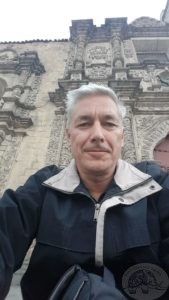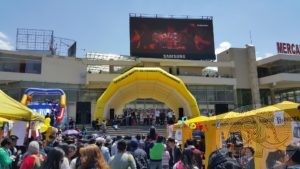La Paz, Bolivia
La Paz is an amazing city. I was going to use the term ‘nestled’ to describe the city’s location, but that is not the right word. This sprawling metropolis is located in the canyon created by the Choqueyapu River. The city’s core consists of several major thoroughfares, parks and squares, while urban sprawl has moved up the sides of the valley and spilled into the next valley. The main airport is situated on top of a narrow mountain peak, and when I viewed it from the bus, I was glad I had opted for the day-long bus trip instead of a quick flight to, what to me, seemed like an impossible landing strip. I read just a few days ago that the city, like several others throughout South America, was making use of a cable car system to provide public transport to certain areas of the city and the neighbouring area of El Alto. The system, as of 2017, was nearly 17 kilometers in length with more extensions planned that will eventually provide nearly 40 kilometers of transportation via cable car or “teleferico”. I had no time to experiment with this form of transport – you might say that I was fortunate in my misfortune as I really do not like cable cars – but I can understand the logic behind the systems, as they often reduce travel times dramatically by providing direct travel from hill-side communities to locations further down or up the valley instead of forcing inhabitants to travel the tortuous and winding roads to their destination.
As my bus wound its way along the heavily clogged road outside the city, several striking metal ‘works of art’ dotted the approach to the city, including one monstrous creation that is a statue of Che Guevara. Made entirely of scrap metal, including car engines, cogs, wheels and others, this statue is 30 meters tall, and visible for quite a distance. I noticed other such ‘artworks’ as I traveled through the country, but will mention them when it’s the right time. La Paz is recognized as the capital city situated at the highest altitude in the world, and as with previous locations I had been to – Cusco, Bogota, Puno all at elevations of more than 3,000 metres – La Paz also caused me some problems when I first arrived. Climbing the thousands of steps from my accommodation to any other area of the city was necessarily done at a slow pace for the first day. After a full day of travel by bus, I had to find a taxi at the main bus terminal to take me the remainder of the way to my accommodation.
Exploring the city and its back streets
The accommodation I had found through a booking website was actually a converted residence/guest house built for clergy of the Catholic church. The rooms were spacious enough, although the bathroom facilities were shared. The Residencial Latino was reasonably priced, and although old, was clean and comfortable. Late in the afternoon I finally checked in, and having figured out where exactly I was in relation to the city center, I set out in search of a new SIM card, or chip. The temperature, still well above 20 degrees during the day time, fell rapidly after sunset, and soon I was shivering as I slowly made my way down to the main square and a market area where, I was assured, I would be able to buy just the thing I was looking for. After 20 minutes of trying various shops, I walked out with a card that worked, and I was back online. I had unfortunately only planned for one full day in La Paz, and I regretted that decision the following morning as I started to wander around the old city area.
It was the weekend, and I took in some of the architecture and art on display in various areas. In one of the main squares of the city a festival promoting small start-ups from universities and technical colleges was in full swing and it was interesting to walk through the exhibits. Only a short distance from this event I also found a gallery with an exhibition of photographs from around South America, with a work-shop taking place that very day in the courtyard.

“Multi-colour Heart” Ximena Toro, 2016, one of the photographs on display at the International Photography Festival, Bolivia.
There were several market streets nearby, including streets that offered plenty of products for tourists, and it was in one of these small side streets that I finally broke down and bought a sweater and scarf as I had been reading up on the climate conditions that I would face over the next few days as I joined a 4-day journey across the Salar de Uyuni – a large salt plain high in the Andes mountains of Bolivia. The purchase, costing a total of 15 dollars, was money well spent, and the Alpaca wool kept me relatively warm over the next week.
On to the next adventure – Uyuni
Strikingly, Bolivia is the major producer of Quinoa, and it produces the highest quality crop, with an article of law specifically protecting the genetic material from international conglomerates and their rapacious disregard for farmers or global food crop diversity. (Perhaps an article on the tremendous damage being done by some of these companies in the area of agriculture is suitable in the future). Quinoa was the food of the he Incas, and was domesticated roughly 3 – 4,000 years ago for human consumption. Its origins are South American, including Colombia, Ecuador, Peru, Bolivia and Chile, yet it is Bolivia that produces the best variety.
In the evening of the following day I made the trek back to the bus station. I was trying to find where exactly the bus would be that would take me to Uyuni, and the starting point for the adventures in the mountains of the Altiplano. The trip to this capital city really was too short, and in hindsight I should have spent more time here, but then again, it is an excuse to make a return visit to this country and this city, as there is much more to explore and discover.





